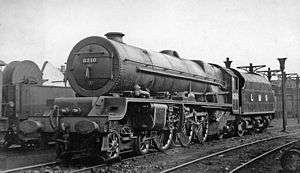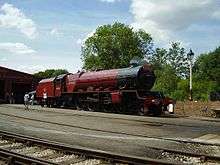LMS Princess Royal Class
The London, Midland and Scottish Railway (LMS) Princess Royal Class is a class of express passenger 4-6-2 steam locomotive designed by William Stanier. Twelve examples were built at Crewe Works, between 1933 and 1935, for use on the West Coast Main Line. Two are preserved.
| Princess Royal Class | |||||||||||||||||||||||||||||||||||||||||||||||||||||||||||||||||||||||||||||||||||||||||
|---|---|---|---|---|---|---|---|---|---|---|---|---|---|---|---|---|---|---|---|---|---|---|---|---|---|---|---|---|---|---|---|---|---|---|---|---|---|---|---|---|---|---|---|---|---|---|---|---|---|---|---|---|---|---|---|---|---|---|---|---|---|---|---|---|---|---|---|---|---|---|---|---|---|---|---|---|---|---|---|---|---|---|---|---|---|---|---|---|---|
 6210 Lady Patricia at its birthplace, Crewe Works, in 1948, still in LMS livery and carrying its LMS number. | |||||||||||||||||||||||||||||||||||||||||||||||||||||||||||||||||||||||||||||||||||||||||
| |||||||||||||||||||||||||||||||||||||||||||||||||||||||||||||||||||||||||||||||||||||||||
| |||||||||||||||||||||||||||||||||||||||||||||||||||||||||||||||||||||||||||||||||||||||||
| |||||||||||||||||||||||||||||||||||||||||||||||||||||||||||||||||||||||||||||||||||||||||
| |||||||||||||||||||||||||||||||||||||||||||||||||||||||||||||||||||||||||||||||||||||||||
Overview
The Princesses are related to the GWR King Class, the general outline essentially being a King with a larger firebox supported by additional trailing wheels. This origin is explained by the designer William Stanier coming from the GWR to the LMS.
When originally built, they were used to haul the famous Royal Scot train between London Euston and Glasgow Central.
Construction
A prototype batch of three locomotives was to be constructed in 1933. Two were constructed as drawn but the third set of frames was retained as the basis for an experimental turbine locomotive.[1][2] [3]
Turbomotive
The third prototype was constructed with the aid of the Swedish Ljungstrom turbine company and known as the Turbomotive, although not named. It was numbered 6202, in sequence with the Princess Royals. Although 'generally similar' to the rest of the Princess Royals,[1] and 'not all that much different',[4] it used a larger 40 element superheater to give a higher steam temperature, more suitable for turbine use.[2][5][note 1] This boiler was also domeless as would later be used for the second batch of the Princess Royals. The continuous exhaust of the turbine, rather than the sharper intermittent blast of the piston engine, also required changes to the draughting and the use of a double chimney.[6][7] It entered service in June 1935 on the London–Liverpool service.[8]
This Turbomotive was rebuilt in 1952 with conventional 'Coronation' cylinders and named Princess Anne, but was soon destroyed in the Harrow and Wealdstone rail crash.[7]
Later production
A second batch of eleven locomotives was constructed later.[9]
Accidents and incidents
- On 17 April 1948 a passenger train hauled by locomotive No.6207 Princess Arthur of Connaught was halted after a passenger pulled the communication cord. It was then hit from behind by a postal train, which a signalman's error had allowed into the section, resulting in the deaths of 24 passengers.
- On 21 September 1951, locomotive No.46207 Princess Arthur of Connaught was hauling an express passenger train that was derailed at Weedon, Northamptonshire due to a defective front bogie on the locomotive. Fifteen people were killed and 35 were injured.
Naming
Each locomotive was named after a princess, the official name for the class was chosen because Mary, Princess Royal was the Colonel-in-Chief of the Royal Scots. However, the locos were known to railwaymen as "Lizzies", after the second example of the class named for Princess Elizabeth who later became Queen Elizabeth II of the United Kingdom. Later examples of 4-6-2 express passenger locomotive built by the LMS were of the related but larger, Coronation Class.
Withdrawal
The class was withdrawn in the early 1960s in line with British Railways' modernisation plan.
Details
| LMS No. |
BR No. |
Name(s) | Date Built |
Date Withdrawn |
Notes |
|---|---|---|---|---|---|
| 6200 | 46200 | The Princess Royal | 27 July 1933 | 17 November 1962 | Last to be withdrawn. |
| 6201 | 46201 | Princess Elizabeth | 3 November 1933 | 20 October 1962 | Preserved. |
| 6203 | 46203 | Princess Margaret Rose | 1 July 1935 | 20 October 1962 | Preserved. Owned by the Princess Royal Class Locomotive Trust. |
| 6204 | 46204 | Princess Louise | 19 July 1935 | 7 October 1961 | . |
| 6205 | 46205 | Princess Victoria | 24 July 1935 | 25 November 1961 | Fitted with modified valve gear in 1947. Converted back to normal in 1955. |
| 6206 | 46206 | Princess Marie Louise | 1 August 1935 | 20 October 1962 | . |
| 6207 | 46207 | Princess Arthur of Connaught | 9 August 1935 | 25 November 1961 | Appeared in the 1930s classic documentary film No. 6207; A Study in Steel which showed the production of the locomotive from molten steel to the finished product. |
| 6208 | 46208 | Princess Helena Victoria | 16 August 1935 | 20 October 1962 | . |
| 6209 | 46209 | Princess Beatrice | 23 August 1935 | 29 September 1962 | . |
| 6210 | 46210 | Lady Patricia | 6 September 1935 | 7 October 1961 | . |
| 6211 | 46211 | Queen Maud | 18 September 1935 | 7 October 1961 | . |
| 6212 | 46212 | Duchess of Kent | 21 October 1935 | 7 October 1961 | . |
Preservation
Two examples, 6201 Princess Elizabeth and 6203 Princess Margaret Rose are preserved and both have operated on the mainline in preservation. They were named after the two children of Prince Albert, Duke of York (later King George VI), and his wife, Elizabeth, Duchess of York (later Queen Elizabeth, and after the king's death, Queen Elizabeth the Queen Mother). Princess Elizabeth Alexandra Mary (later Queen Elizabeth II) was seven years old in 1933 when her namesake was built, and Princess Margaret Rose was nearly five in July 1935 when her namesake was completed. At the time, they were third and fourth in line to the throne. 'Princess Margaret Rose' is owned by The Princess Royal Class Locomotive Trust and is on static display at the West Shed Museum, Midland Railway-Butterley, Ripley, Derbyshire.
| Number | Name | Built | Withdrawn | Service Life | Livery | Location | Owners | Status | Mainline Certified | Photograph | Notes | |
|---|---|---|---|---|---|---|---|---|---|---|---|---|
| LMS | BR | |||||||||||
| 6201 | 46201 | Princess Elizabeth | Nov 1933 | Oct 1962 | 28 Years, 11 Months | LMS Crimson Lake | Carnforth MPD | 6201 Princess Elizabeth Society | Operational | Yes (2019–2026) |  |
Recently returned to service following a retube due to multiple tube problems alongside boiler and firebox issues.[10] |
| 6203 | 46203 | Princess Margaret Rose | Jul 1935 | Oct 1962 | 27 Years, 3 Months | BR Crimson Lake, Late Crest | Butterley | Princess Royal Class Locomotive Trust | Static Display | No |  |
|
Gallery
 46201 Princess Elizabeth at Carlisle awaiting scrapping. The locomotive was later preserved.
46201 Princess Elizabeth at Carlisle awaiting scrapping. The locomotive was later preserved. Princess Margaret Rose at Swanwick West Shed in 2006.
Princess Margaret Rose at Swanwick West Shed in 2006.
Media
- 6201 at Langho on Whalley Bank – sound recording.
References
- This trifurcated superheater design was later used on the Duchess class.[2]
- Nock, p. 114
- Cook, A.F. (1999). Raising Steam on the LMS. RCTS. pp. 126–127. ISBN 0-901115-85-1.
- Rowledge, J.W.P. (1987). "3: The Princess Royal Class – The First Two". The LMS Pacifics. David & Charles. pp. 24–35. ISBN 0-7153-8776-6.
- Fryer 1990, p. 165
- Rowledge, J.W.P. (1987). "4: The 'Turbomotive'". The LMS Pacifics. David & Charles. p. 47. ISBN 0-7153-8776-6.
- "9: Unconventional Locomotives 1929–1935". The British Steam Railway Locomotive. II: from 1925 to 1965. Ian Allan. 1966. pp. 112–117. ISBN 0-7110-0125-1.
- "18: Stanier's 'Turbomotive'". Experiments With Steam. Patrick Stephens Limited. 1990. pp. 163–171. ISBN 1-85260-269-4.
- Fryer 1990, p. 167
- Rowledge, J.W.P. (1987). "5: The Princess Royal Class – Modifications, and the 1935 Batch". The LMS Pacifics. David & Charles. pp. 44–51. ISBN 0-7153-8776-6.
- https://www.railadvent.co.uk/2019/03/steam-locomotive-6201-princess-elizabeth-on-the-mainline-this-wednesday.html
- Ian Sixsmith The Book of the Princess Royal Pacifics ISBN 1-903266-02-5
- Hugh Longworth British Railway Steam Locomotives 1948–1968 ISBN 0-86093-593-0
- Rowledge, J.W.P. (1975). Engines of the LMS, built 1923–51. Oxford: Oxford Publishing Company. ISBN 0-902888-59-5.
- David Hunt, Bob Essery and Fred James LMS Locomotive Profiles No. 4: The "Princess Royal" Pacifics
External links
| Wikimedia Commons has media related to LMS Princess Royal Class. |